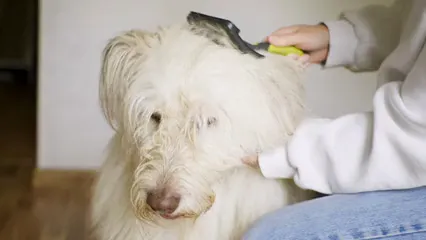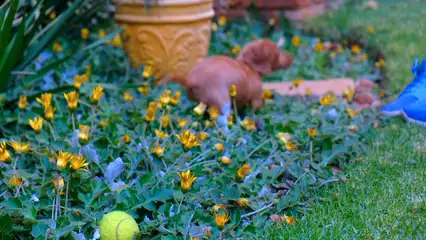Introduction
Trimming your dog’s nails is crucial for their well-being. Overgrown nails can cause pain and discomfort. They can even lead to mobility issues. This process, however, often feels like a wrestling match. Many dogs cringe at the sight of clippers. As owners, we feel their anxiety, making us dread nail trimming sessions.
But fear not! This guide aims to turn nail trimming into a calm and enjoyable experience. With a step-by-step approach, you’ll learn how to trim your dog’s nails at home without stress.
Imagine bonding with your dog during this grooming task. A stress-free session means more cuddles and happier tails. So grab those clippers and let’s get started!

Understanding the Importance of Nail Trimming
Why Nail Trimming is Essential
Long nails can lead to various health problems. They can cause pain in your dog’s paws. When nails grow too long, they put pressure on toe joints. This can result in discomfort and even arthritis over time.
Additionally, long nails are prone to breaking. A broken nail can lead to infections and further complications. Regular trimming helps to prevent these issues. It keeps your furry friend happy and healthy.
Regular nail trims also improve your dog’s mobility. Short nails allow for better traction. This is especially important for active pups who love to play. Keeping nails trimmed can enhance their overall quality of life.

Signs Your Dog Needs a Trim
So, when should you grab those clippers? A good rule of thumb is to listen for the sound of nails clicking on hard floors. If you hear that sound, it’s time for a trim!
Visually, you can check your dog’s nails. If the nails are touching the ground when standing, they are too long. Ideally, nails should be just above the floor.
The frequency of nail trimming varies. Active dogs may wear down their nails naturally. However, for less active pups, a trim every 3-4 weeks is usually best. Adjust this based on your dog’s lifestyle and activity level.
Remember, a regular nail trimming routine is essential for your dog’s health. Don’t wait until it becomes a problem. Keeping those nails short will ensure a happy, healthy pup!
Preparing for the Nail Trim
Gather the Right Tools
Before you grab your pup and a pair of clippers, let’s talk tools. First up, you’ll need nail clippers. Look for sharp, strong ones. The guillotine-style is popular, but don’t forget a good Dremel Dog Nail Grinder. It smooths edges and helps avoid those dreaded quick cuts. If your dog has dark nails, a Dremel can be your best friend.
Now, let’s not forget styptic powder. Accidents happen, and having this handy can save the day if you accidentally cut too close. It’s like a superhero for those moments! If you can’t find any, cornstarch works in a pinch. Just be smart about it—using the right tools can make all the difference.
Size matters, too! Choose clippers that fit your dog’s size. Small clippers for tiny paws and larger ones for big dogs. Sharp clippers ensure clean cuts. Dull ones can crush nails, causing pain. Trust me, nobody wants that!

Create a Calm Environment
Now that you’re armed with the right tools, let’s set the mood. Create a calm and cozy environment. Choose a well-lit space with minimal distractions. Your dog will appreciate it! Maybe avoid the living room if the TV is blasting.
Think about laying down a non-slip mat. This will help your dog feel secure while you trim. If they’re fidgety, a comfy spot can be a game-changer.
And here’s a pro tip: have some treats ready! Not just any treats—think high-value goodies. Peanut Butter Dog Treats on a spoon is a classic! This will help create positive associations with nail trimming. Every time you grab the clippers, your dog should think, “Yay, treats!” This little trick can turn a scary experience into a fun one.
So, keep the environment chill and rewarding. Play some soft music, and keep your voice soothing. You want your pup to feel safe and relaxed. You got this!

Desensitizing Your Dog to Nail Trimming
Gradual Acclimatization
Now it’s time for a little training session! Start by introducing your dog to the nail clippers. Let them sniff it and get comfortable. Place the clippers on the floor, and reward them when they approach. Treats and gentle praise work wonders!
Next, let’s touch those paws. Start with gentle petting. If they flinch, don’t worry—it’s normal. Gradually work up to holding their paw and touching each nail. Positive reinforcement is key! Use treats and praise like they’re going out of style.
Once your dog seems cool with the clippers and you touching their paws, it’s time to make some noise. Squeeze the clippers near their paws. If they stay calm, give them a treat! This will help them associate the sound with something good.
Now, let’s combine steps. Hold their paw, touch the clippers, and make that snipping sound. If they get anxious, go back a step. No rush—this is a process, not a race.
When they’re ready, try trimming just the tip of one nail. Celebrate with treats and praise! Slowly increase the number of nails you trim in each session. Take breaks if needed. The goal is to keep it positive and stress-free.
Remember, patience is your best friend here. It may take days or even weeks, but with each session, you’re building trust and comfort. Soon, nail trimming will be a breeze!

Building Comfort with Handling
Handling your dog’s paws regularly is key. Start by gently massaging their paws during cuddle time. This builds familiarity and trust. Use treats to reward positive behavior. Keep the sessions short and sweet, so they don’t get overwhelmed.
Introduce the clippers slowly. Let your pup sniff them first. This transforms the clippers from a scary object into a familiar friend. Each time you touch their paws, praise them and offer a treat. This positive reinforcement helps reduce anxiety.
Practice makes perfect! Regularly hold their paws while watching TV or lounging together. The more comfortable they are, the smoother nail trimming will be. Take your time, and remember to breathe. Your calmness will help your pup relax too!

The Nail Trimming Process
Step-by-Step Guide to Trimming Nails
1. Positioning Your Dog
Finding the right position is crucial. For most dogs, a sitting position works best. It gives them stability while you trim. If your dog feels more comfortable lying down, go for that option! Just ensure you can easily reach their paws.
You might need a helper for larger dogs. They can hold your pup gently, keeping them calm. If your dog starts to squirm, take a break. The goal is to keep it positive. Choose a quiet space where your dog feels safe.
Always keep treats nearby! Rewarding your dog for sitting still will encourage good behavior. Remember, patience is key. Don’t rush through the process.

2. Clipping Technique
Ah, the art of clipping! Start by examining your dog’s nails. For clear nails, look for the pink quick. This is where the blood vessels are. Always trim just the tip, staying clear of the quick.
For dogs with dark nails, it’s trickier. You can’t see the quick, so take your time. Trim small bits and watch for a change in color. If you see a light ring, you’re getting close. Stop if you see more black than white.
Distracting your dog is a game-changer! Use dog chew toys or dog training treats. This keeps them busy while you work. If they seem anxious, pause and refocus. The goal is to create a calm atmosphere.
If your pup resists, try again later. You can always split the trimming across multiple days. Celebrate small victories, like trimming just one nail. This helps build confidence for both you and your dog.

3. Using a Dremel
Consider using a Dremel for a smoother finish. It’s less intimidating for some dogs compared to clippers. Dremels grind the nail down, reducing the risk of cutting the quick. Plus, they can create neat edges, preventing snagging.
To use a Dremel effectively, start on a low speed. Hold your dog’s paw gently and touch the Dremel to the nail. Make sure your dog is comfortable with the sound. If they’re unsure, go slow and reward them frequently.
Take breaks during the process. If your dog gets restless, pause and give them a treat. This helps reinforce the idea that nail trimming is a positive experience.
Using a Dremel can be a great alternative, especially for dogs with thicker nails. Just remember to keep the tool steady and maintain a calm demeanor. Your pup will appreciate the gentle approach!
Ending on a Positive Note
Always conclude your nail trimming sessions positively! Give your dog plenty of praise and treats after a successful trim. This reinforces good behavior and makes them more likely to cooperate next time. A happy ending is the best way to ensure your dog looks forward to future trims.
Troubleshooting Common Issues
Dealing with Fear and Resistance
Trimming a fearful dog’s nails can feel like trying to wrestle a greased pig. But don’t worry! There are ways to tackle this challenge without turning it into a circus act.
First things first: patience is your secret weapon. Start by getting your dog accustomed to the nail clippers. Let them sniff it. Reward them with treats for being brave. Positive reinforcement works wonders!
Next, try distraction techniques. Have a helper hold your dog gently. Offer them a favorite chew or a lick of peanut butter on a spoon. This keeps their focus away from the clippers.
If your dog is particularly anxious, take it slow. Just touch their paws for a few seconds, then reward them. Gradually increase this time, building their comfort level.
For extremely nervous dogs, don’t hesitate to consult a professional groomer or trainer. Sometimes, a gentle touch from an experienced hand can make all the difference. If the anxiety persists, discussing sedation options with your vet might be worthwhile. After all, a calm dog is a happy dog!

Handling Accidents
Oops! You’ve cut the quick—now what? Don’t panic. Accidents happen to the best of us. The key is to act quickly and calmly.
First, apply pressure to the nail with a clean cloth or gauze. This helps stop the bleeding. Next, reach for your handy styptic powder. If you don’t have that, cornstarch can work in a pinch. Just dab it onto the bleeding nail and hold it for a couple of minutes.
If the bleeding doesn’t stop after a few minutes, or if the cut seems severe, it’s time to call the vet. They can provide additional care and ensure everything is okay.
Remember, even seasoned pros have mishaps. The important thing is to remain calm and reassure your dog. A soothing voice and gentle pats can help ease their fears after an accident. They will soon learn that nail trimming isn’t so scary after all, and you’ll both be pros in no time!

Conclusion
Trimming your dog’s nails doesn’t have to be a hair-raising experience. We’ve covered the essentials to make this grooming task both manageable and enjoyable. Remember, preparation is key. Gather the right tools, create a calm environment, and approach the process with patience. This is not just a chore; it’s an opportunity to strengthen your bond with your furry friend.
By desensitizing your pup and using positive reinforcement, you can turn nail trimming into a pleasant routine. Consistency is crucial; with regular practice, your dog will learn that clippers mean treats and cuddles, not fear.
So, take a deep breath, stay relaxed, and keep those treats handy! Nail trimming can be a delightful bonding experience. Be patient and celebrate each small victory. Your dog will thank you with wagging tails and happy barks.

FAQs
What if my dog has never had their nails trimmed?
If your dog has never experienced a nail trim, start slow. Introduce them to the nail clippers gradually. Let them sniff the clippers and reward them with treats for calm behavior. Handle their paws gently to foster familiarity. Begin by just touching the clippers to their nails without cutting. This desensitization process may take time, but patience pays off. Remember, progress over perfection!
How often should I trim my dog’s nails?
The frequency of nail trimming varies by breed and activity level. Generally, dogs should have their nails trimmed every 3-4 weeks. Active dogs may wear down their nails naturally, while less active pups might need more frequent trims. Regular checks will help you gauge when it’s time. If their nails click on hard floors, it’s likely time for a trim!
Can I use human nail clippers on my dog?
It’s not advisable to use human nail clippers on dogs. Human clippers can crush the nail rather than providing a clean cut. This can lead to pain and discomfort for your pup. Dog nail clippers are specifically designed to suit their needs, ensuring a safe and comfortable trimming experience.
What if my dog won’t let me touch their paws?
If your dog is resistant to having their paws touched, start by building trust. Gradually touch their paws during relaxed moments, like during cuddle time. Use treats and praise to create a positive association. You can also try placing their favorite toy nearby to distract them. Take your time, and don’t rush. Patience is key in this process!
Should I trim my dog’s nails in the morning or evening?
The best time to trim your dog’s nails often depends on their behavior and energy levels. Many dogs are calmer and more relaxed in the evening after a day of activity. However, some dogs may prefer morning trims when they’re still fresh. Observe your dog’s behavior to find the optimal time. Whatever you choose, keep it consistent to help them adjust!
Please let us know what you think about our content by leaving a comment down below!
Thank you for reading till here 🙂
If your dog is anxious during thunderstorms, consider exploring natural remedies for dog anxiety during thunderstorms to help them feel more at ease.
All images from Pexels





